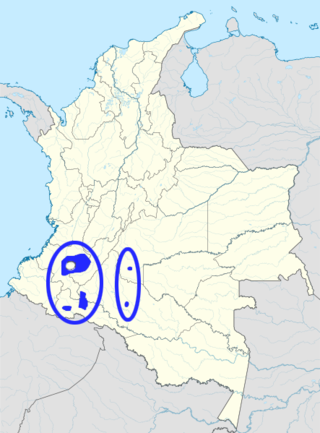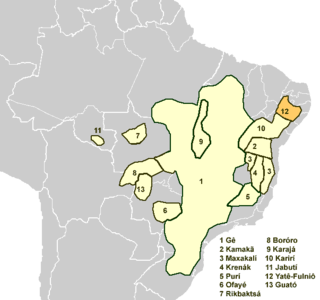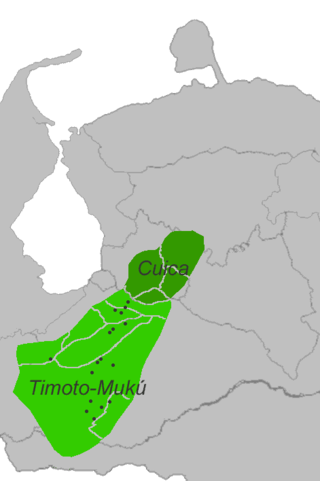
Quechua, also called Runasimi in Southern Quechua, is an indigenous language family that originated in central Peru and thereafter spread to other countries of the Andes. Derived from a common ancestral "Proto-Quechua" language, it is today the most widely spoken pre-Columbian language family of the Americas, with the number of speakers estimated at 8–10 million speakers in 2004, and just under 7 million from the most recent census data available up to 2011. Approximately 13.9% of Peruvians speak a Quechua language.

Aymara is an Aymaran language spoken by the Aymara people of the Bolivian Andes. It is one of only a handful of Native American languages with over one million speakers. Aymara, along with Spanish and Quechua, is an official language in Bolivia and Peru. It is also spoken, to a much lesser extent, by some communities in northern Chile, where it is a recognized minority language.
In recent years, Peru has revised the official spelling for place-names originating from Aymara and the Quechuan languages. A standardized alphabet for done Quechua was adopted by the Peruvian government in 1975; a revision in 1985 moved to a three-vowel orthography.

Jaqaru (Haq'aru) is a language of the Aymaran family. It is also known as Jaqi and Aru. It is spoken in the districts of Tupe and Catahuasi in Yauyos Province, Lima Region, Peru. Most of the 2000 ethnic Jaqaru have migrated to Lima.

South Bolivian Quechua, also known as Central Bolivian Quechua, is a dialect of Southern Quechua spoken in Bolivia and adjacent areas of Argentina, where it is also known as Colla. It is not to be confused with North Bolivian Quechua, which is spoken on the northern Andean slopes of Bolivia and is phonologically distinct from the South Bolivian variety. Estimates of the number of speakers of South Bolivian Quechua range from 2.3 to 2.8 million, making it the most spoken indigenous language in Bolivia, just slightly greater than Aymara, with roughly 2 million speakers in Bolivia. In comparison, the North Bolivian dialect has roughly 116,000 speakers.

Peru has many languages in use, with its official languages being Spanish, Quechua and Aymara. Spanish has been in the country since it began being taught in the time of José Pardo instead of the country's Native languages, especially the languages in the Andes. In the beginning of the 21st century, it was estimated that in this multilingual country, about 50 very different and popular languages are spoken: which reduces to 44 languages if dialects are considered variants of the same language. The majority of these languages are Indigenous, but the most common language is Spanish, the main language that about 94.4% of the population speaks. Spanish is followed by the country's Indigenous languages, especially all types of Quechua and Aymara (1.7%), who also have co-official status according to Article 48 of the Constitution of Peru, as well as the languages of the Amazon and the Peruvian Sign Language. In urban areas of the country, especially the coastal region, most people are monolingual and only speak Spanish, while in many rural areas of the country, especially in the Amazon, multilingual populations are prevalent.

Puquina is a small, putative language family, often portrayed as a language isolate, which consists of the extinct Puquina language and Kallawaya, although it is assumed that the latter is just a remnant of the former mixed with Quechuan. Puquina speakers are last mentioned in the early nineteenth century.

Páez is a language of Colombia, spoken by the Páez people. Crevels (2011) estimates 60,000 speakers out of an ethnic population of 140,000.

Southern Quechua, or simply Quechua, is the most widely spoken of the major regional groupings of mutually intelligible dialects within the Quechua language family, with about 6.9 million speakers. Besides Guaraní it is the only indigenous language of America with more than 5 million speakers. The term Southern Quechua refers to the Quechuan varieties spoken in regions of the Andes south of a line roughly east–west between the cities of Huancayo and Huancavelica in central Peru. It includes the Quechua varieties spoken in the regions of Ayacucho, Cusco and Puno in Peru, in much of Bolivia and parts of north-west Argentina. The most widely spoken varieties are Cusco, Ayacucho, Puno (Collao), and South Bolivian.
Kunza is an extinct language isolate once spoken in the Atacama Desert of northern Chile and southern Peru by the Atacama people, who have since shifted to Spanish. The last speaker was documented in 1949.
Chipaya is a native South American language of the Uru–Chipaya language family. The only other language in the grouping, Uru, is considered by some to be a divergent dialect of Chipaya. Ethnologue lists the language vitality as "vigorous," with 1,800 speakers out of an ethnic population of around 2,100, although younger generations speak it progressively less. Chipaya has been influenced considerably by Aymara, the Quechuan languages, and more recently, Spanish, with a third of its vocabulary having been replaced by those languages.

The demographic history of Peru shows the structure of the population in different historical periods. Peru’s population drastically increased in the 1900s, with a diverse range of ethnic divisions living in the country. Lima is its capital city situated along the Pacific Ocean coast, where most of its population lives, and its population size is around 9.75 million. Major cities are located near the coastal areas of Peru. In terms of population and area size, it is the fourth and third largest country in South America, a place where the ancestral transcends and all forms of art combine. Peru became an independent country on July 28, 1821. However, Peru did not have a proper national census until 1876, more than a half-century after independence. They took the data before the federal census through different mediums but not on a national level. The significant migration in Peru consisted of Indigenous people, Europeans, enslaved Africans, and Asians; Spaniards were the first European who came to Peru, arrived in 1531, and discovered the Inca culture. The Incas established pre-Columbian America's greatest and most advanced kingdom and monarchy. However, native Americans were still in a larger proportion to total population.

Harakmbut or Harakmbet is the native language of the Harakmbut people of Peru. It is spoken along the Madre de Dios and Colorado Rivers, in the pre-contact country of the people. There are two dialects that remain vital: Amarakaeri (Arakmbut) and Watipaeri (Huachipaeri), which are reported to be mutually intelligible. The relationship between speakers of the two dialects is hostile.
Quechumaran or Kechumaran is a language-family proposal that unites Quechua and Aymara. Quechuan languages, especially those of the south, share a large amount of vocabulary with Aymara. The hypothesis of the existence of Quechuamara was originally posted by linguist Norman McQuown in 1955. Terrence Kaufman finds the proposal reasonably convincing, but Willem Adelaar, a Quechua specialist, believes the similarities to be caused by borrowing during long-term contact. Lyle Campbell suspects that the proposal is valid but does not consider it to have been conclusively proved.
Pacaraos Quechua is a variety of Quechua spoken until the middle of the 20th century in the community of Pacaraos in the Peruvian Lima Region in the Chancay valley up to 3000 m above sea level.

Fulniô, or Yatê, is a language isolate of Brazil, and the only indigenous language remaining in the northeastern part of that country. The two dialects, Fulniô and Yatê, are very close. The Fulniô dialect is used primarily during a three-month religious retreat. Today, the language is spoken in Águas Belas, Pernambuco.

The Timotean languages were spoken in the Venezuelan Andes around what is now Mérida. It is assumed that they are extinct. However, Timote may survive in the so-far unattested Mutú (Loco) language, as this occupies a mountain village (Mutús) within the old Timote state.

The indigenous languages of the Americas form various linguistic areas or Sprachbunds that share various common (areal) traits.

The indigenous languages of South America are those whose origin dates back to the pre-Columbian era. The subcontinent has great linguistic diversity, but, as the number of speakers of indigenous languages is diminishing, it is estimated that it could become one of the least linguistically diverse regions of the planet.
Proto-Quechuan language is the hypothetical mother tongue or proto-language that would have given rise to the various languages of the Quechuan languages. This proto-language is reconstructed based on evidence from modern Quechuan languages, as well as records of ancient forms.














